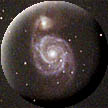| THE FIRST SCENES | ||
 |
Deepsky in Spring --Scenic spots in spring sky | |
| 321 images displayed, Last updated on Dec 13, 2025 |
We can appreciate no flows of the Milky Way in spring skies. And few celestial objects are scattered suitable for compact binoculars.
But there are uncountable far and far galaxies beyond our home Galaxy because spring skies include no inner-galactic gaseous matter obstructing dimmed galaxies. Although it might be needed telescopes to enjoy seeing them, a season of spring is most suitable for observing various figures of galaxy's individualities.
 .....Objects with this mark include pages of spectral profiles taken with a spectrometer.
.....Objects with this mark include pages of spectral profiles taken with a spectrometer.
 Galaxies in Spring Part 1 (Northern Area)
Galaxies in Spring Part 1 (Northern Area)